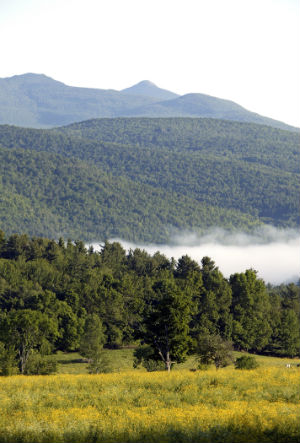 The landscape of Vermont has experienced many changes during our history. One of the constants has been a working forest landscape that provides goods and services through forest stewardship, management, and conservation. Sustainably managing forests involves the recognition of the ecological, social, and economic systems necessary to maintain forest health while still providing benefits for the current and future generations.
The landscape of Vermont has experienced many changes during our history. One of the constants has been a working forest landscape that provides goods and services through forest stewardship, management, and conservation. Sustainably managing forests involves the recognition of the ecological, social, and economic systems necessary to maintain forest health while still providing benefits for the current and future generations.
Vermont’s forests cover 4,591,281 acres of land. That is equal to 78% of the state, a level which has remained steady since the 1980s. Like most eastern states, Vermont has relatively little public land. The Green Mountain National Forest has two large blocks of land in Vermont, and the state and numerous municipalities own many parcels of forests and parks. Still, this accounts for only 19% of the forest. Individuals and families own more than 80% of the forest. Unlike other northeastern states with large corporate ownerships, only 1% of Vermont’s forest is owned by businesses, including timberland investment management organizations (TIMOs) and Real Estate Investment Trusts (REITs).
The forests of Vermont are as diverse as the landowners that care for them. Vermont lies within a biological transition zone between the northern boreal forests to the southern deciduous forests. The northern hardwood mix of beech, birch, and maple dominates Vermont’s forests, accounting for 71% of the forest cover. With sugar maple making up close to 20% of total growing stock of our forest, it is little wonder why it is Vermont’s state tree.
The economic importance of Vermont’s working forest has garnered considerable attention as of late. This recognition has seen a renaissance in the “Buy Local” movement, which started with food but now includes forests. From firewood to lumber, biomass to fine furniture, carbon sequestration to clean water, our forests have value. Forest-based manufacturing and forest-related recreation and tourism are significant economic drivers for Vermont, resulting in a substantial contribution to our state’s economy.
Across the state, the volume of trees continues to increase and net growth exceeds the harvest annually, although this ratio is experiencing a decline. Current inventories show that Vermont’s forests add 2.4 million cords in growth per year while approximately 1.4 million cords of timber are harvested. Put in perspective, Vermont’s standing forest holds 80 million cords of timber, which includes all trees 5 inches in diameter or larger.
When we consider the forests of Vermont, it is important that we look across the rural to urban continuum from the top of Mount Mansfield to the downtown of the Church Street Marketplace in Burlington, Vermont. All trees and forests in Vermont provide important services that we rely on, whether the individual street tree, backyard forest, town forest, or the thousands of state-owned and managed forests.
Forests are one of Vermont’s greatest assets.
